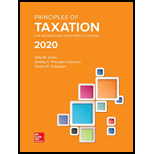
Marla recently inherited $50,000 and is considering two alternatives for investing these funds. Investment A is stock of a C corporation, expected to pay annual dividends of 8 percent. Investment B is stock of an S corporation. Based on income projections, Marla’s share of the S corporation’s ordinary income would be approximately $10,000 per year. However, the S corporation does not expect to make cash distributions for the foreseeable future. Marla would hold either investment for three years, at which time she believes the C corporation stock could be sold for $60,000 and the S corporation stock could be sold for $90,000.
Assume that the initial investment would be made in year 0, dividends on the C corporation stock would be received in years 1, 2, and 3; S corporation earnings would be allocated in years 1, 2, and 3; and either investment would be sold in year 3. Assume that Marla’s S corporation income would not qualify for the QBI deduction. Also assume that Marla’s marginal tax rate on ordinary income is 35 percent. Using a 4 percent discount rate, calculate the
Want to see the full answer?
Check out a sample textbook solution
Chapter 10 Solutions
Principles of Taxation for Business and Investment Planning 2020 Edition
- For the purposes of the 20x0 annual financial statements, how would the additional shares of Series A preferred stock issued from Company Y to Company Y's original investor on November 1 20X0 affect the measurment of the company Y's series A preferred stock purchased on may 1, 20x0?arrow_forwardGeneral Accountingarrow_forwardFinancial Accounting Questionarrow_forward
- What is the investment turnover for this financial accounting question?arrow_forwardSuppose you take out a five-year car loan for $14000, paying an annual interest rate of 4%. You make monthly payments of $258 for this loan. Complete the table below as you pay off the loan. Months Amount still owed 4% Interest on amount still owed (Remember to divide by 12 for monthly interest) Amount of monthly payment that goes toward paying off the loan (after paying interest) 0 14000 1 2 3 + LO 5 6 7 8 9 10 10 11 12 What is the total amount paid in interest over this first year of the loan?arrow_forwardSuppose you take out a five-year car loan for $12000, paying an annual interest rate of 3%. You make monthly payments of $216 for this loan. mocars Getting started (month 0): Here is how the process works. When you buy the car, right at month 0, you owe the full $12000. Applying the 3% interest to this (3% is "3 per $100" or "0.03 per $1"), you would owe 0.03*$12000 = $360 for the year. Since this is a monthly loan, we divide this by 12 to find the interest payment of $30 for the month. You pay $216 for the month, so $30 of your payment goes toward interest (and is never seen again...), and (216-30) = $186 pays down your loan. (Month 1): You just paid down $186 off your loan, so you now owe $11814 for the car. Using a similar process, you would owe 0.03* $11814 = $354.42 for the year, so (dividing by 12), you owe $29.54 in interest for the month. This means that of your $216 monthly payment, $29.54 goes toward interest and $186.46 pays down your loan. The values from above are included…arrow_forward
 Pfin (with Mindtap, 1 Term Printed Access Card) (...FinanceISBN:9780357033609Author:Randall Billingsley, Lawrence J. Gitman, Michael D. JoehnkPublisher:Cengage Learning
Pfin (with Mindtap, 1 Term Printed Access Card) (...FinanceISBN:9780357033609Author:Randall Billingsley, Lawrence J. Gitman, Michael D. JoehnkPublisher:Cengage Learning





